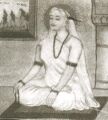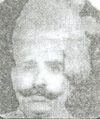Marwar
| Author:Laxman Burdak, IFS (Retd.), Jaipur |
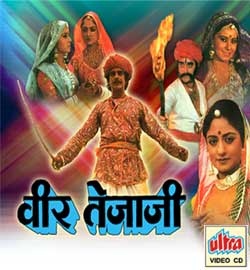
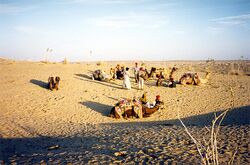
Marwar (मारवाड़) is a region of southwestern Rajasthan state in western India. It lies partly in the Thar Desert.
Variants
- Marupradesha (मरुप्रदेश)
- Marwar मारवाड़ = Maru मरु (AS, p.737)
- Marusthala मरुस्थल (AS, p.737)
- Maru मरु (AS, p.712)
- Marubhu मरुभू = Marubhumi मरुभूमि (AS, p.713)
- Marubhumi मरुभूमि (AS, p.713)
- Marudhanva (मरुधन्व) Mahabharata (III.174.21)
- Registan (रेगिस्तान) (AS, p.712)
- Maruvata/Maruvat/Maruwat (मरूवाट) = "region of death"
- Marusthan
- Marudesha
- Mardesh (by early Muhamadan writers)
Origin of Marwar

The word Marwar is derived from Sanskrit word 'Maruwat'. English translation of the word is "region of death", reflecting harsh climatic conditions. Imperial Gazetteer of India, v. 17, p. 213 defines Marwar as corruption of Maru-wār, classically Marusthala or Marusthan, also called Marudesha, whence is derived the unintelligible Mardesh of the early Muhamadan writers. The word means the 'region of death' and hence is applied to desert.[1]
[[:File:]]
Famous Jats from Marwar
-
Tejaji (1074- 1103)
-
Ranabai (1504-1570)
-
Karmabai (1615 - 1634)
-
Foolabai (1664 - 1682)
-
Gulla Ram (1883 - 1968)
-
Ramdan Dookiya (1884- 1963)
-
Mool Chand Siyag (1887- 1978)
-
Baldev Ram Mirdha (1889-1953)
-
Bhinyaram Sihag (1891-1954)
-
Amara Ram Saran (1916- )
-
Nathuram Mirdha (1921-1996)
-
Ganga Ram Chaudhary (1922 - )
-
Hira Singh Chahar (17.1.1901-30.6.1993)
Click the links below to know details about these great persons from Marwar region :
- Amara Ram Saran - Sawau (Barmer)
- Baldev Ram Mirdha - Kuchera (Nagaur)
- बाबू दूधारामजी
- Chaudhary Bhinya Ram Sihag - Parbatsar (Nagaur)
- Ganga Ram Khileri (चौधरी गंगारामजी खिलेरी) - नागौर
- Chaudhary Gulla Ram - Ratkudiya (Jodhpur)
- Aidan Ram Bhadu (चौधरी आईदानजी भादू) - बाड़मेर
- Chaudhary Mool Chand Sihag - Balwa (Nagaur)
- Dr Pema Ram - Jasnagar (Nagaur)
- Foolabai - Manjuwas (Nagaur)
- Ganga Ram Chaudhary - Karin (Barmer)
- Govardhan Singh Chaudhary - Ratkudiya (Jodhpur), First Jat IAS in Rajasthan
- Guru Jambheshwar
- Harchand Ram Moond - Bataru (Barmer)
- Hema Ram Chaudhary - Baytu Bhimji (Barmer)
- Karmabai - Kalwa (Nagaur)
- Khema Baba - Vayatu (Barmer)
- मास्टर धारा सिंह - Sindhu Jat from Meerut
- Nathuram Mirdha - Kuchera (Nagaur)
- Parasram Maderna - Chadi (Jodhpur)
- Raghuvendra Mirdha
- Ramdan Dookiya - Kharin (खड़ीन) (Barmer)
- Ram Niwas Mirdha - Kuchera (Nagaur)
- Ranabai (1504-1570) - Harnawa (Nagaur)
- Sona Ram - Sri Mohangarh (Jaisalmer)
- Tejaji - Kharnal (Nagaur
History of Marwar
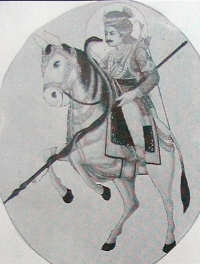
Marwar is erstwhile princely state of Jodhpur. Marwar is the mythic place of Marwari origin. There is no part of India called Marwar. Historian James Tod says that the dry area between river Sutlej and sea was called Marwar in the past. But today it is supposed to be between Sindh, Gujarat, Mewar, Ajmer and Jaipur. Marwar is an imaginary homeland of Marwaris. In 1929 a Hindi magazine “Chand Marwari Ank” (November 1929) published a special Marwari issue, on the past and present conditions of Marwar, noted that the place politically known as Rajputana is geographically and socially known as Marwar.
Present Jodhpur division was called Marwar state before independence. The Jodhpur state was founded in the 13th century by the Rathor clan of Rajputs and was later a vassal of the Mughal empire. Head of the state was Maharaja Jodhpur, assisted by Jagirdars, Jamidars and Thakurs. There were 22 parganas and 4500 villages in Marwar state. The British brought it under their control in 1818, and in 1949 it was merged with the state of Rajasthan. Jodhpur city, capital of the former state and now a district administrative centre, was founded in 1459.
Modern researches have indicated that the land of Marwar was sea in ancient times. The Aravalli hill ranges touched the sea. The sand of the desert is considered to be the coastal sand of the sea. During Jurassic period the desert extended up to Narmada River in the south (Imperial Gazette). There is a myth in the Marwar region that this region was called Hakara Sea. Sugarcane was cultivated on the coast of this sea. The traces of stone oil mill (kolhu) are still found in the area.
In Mahabharata
- Marudhanva (मरुधन्व) Mahabharata (III.174.21),
- Marubhumi (मरु भूमि) (II.29.5), (V.19.29),
- Marubhauma (मरुभौम) (VI.10.46),
Vana Parva, Mahabharata/Book III Chapter 174 mentions Pandavas journey in twelfth year of their sojourn in forests having arrived reach Saraswati River. Marudhanva (मरुधन्व) is mentioned in Mahabharata verse (III.174.21). [2]....repaired cheerfully from that Chitraratha-like forest to the borders of the desert, and desirous of dwelling by the Saraswati they went there, and from the banks of that river they reached the lake of Dvaitavana.
Sabha Parva, Mahabharata/Book II Chapter 29 mentions the Countries subjugated by Nakula in West. Marubhumi (मरु भूमि) is mentioned in Mahabharata (II.29.5). [3]....And the encounter the son of Pandu had with the Mattamayurakas of that country was fierce. And the illustrious Nakula after this, subjugated the whole of the desert country (Marubhumi).
Udyoga Parva/Mahabharata Book V Chapter 19 mentions Kings Who joined Kauravas for war. ... Marubhumi (मरु भूमि) is mentioned in verse (V.19.29).[4] ...there was no space in the city of Hastinapura even for the principal leaders of Duryodhana's army. ...And for this reason the land of the five rivers, and the whole of the region called Kuru-jangala, and the forest of Rohitaka (Rohitakaranya) which was uniformly wild (Marubhumi), and Ahichhatra and Kalakuta, and the banks of the Ganga, and Varana, and Vatadhana, and the hill tracts on the border of the Yamuna--the whole of this extensive tract--full of abundant corn and wealth, was entirely overspread with the army of the Kauravas.
Bhisma Parva, Mahabharata/Book VI Chapter 10 describes geography and provinces of Bharatavarsha. Marubhauma (मरुभौम) is mentioned in (VI.10.46). [5]... Aparandhras, the Shudras, the Pahalvas, the Charmakhandikas; the Atavis, Shabaras, Marubhaumas, Marishas...
Marudha (मरुध) were The Mahabharata Tribe Defeated by Sahdeva in the south (II.28.7), they may be the Madhka in Yudhisthira's army. Both 'Maru' and 'Mada' are found in inscriptions; could refer to Jodhpur and Jaisalmer states (modern Marwar). Marudhanva is a term for desert and Marudha may, derive from it.
मारवाड़
मारवाड़ (AS, p.737): राजस्थान में भूतपूर्व जोधपुर रियासत का परिवर्ती भाग मारवाड़ कहलाता है. इसका प्राचीन नाम मरु था जिसका अर्थ है मरुस्थल. (दे. मरु)[6]
मारवाड़ परिचय
मारवाड़ उत्तर मुग़ल काल में राजस्थान का एक विस्तृत राज्य था। मारवाड़ संस्कृत के मरूवाट शब्द से बना है जिसका अर्थ है मौत का भूभाग। मारवाड़ को मरुस्थल, मरुभूमि, मरुप्रदेश आदि नामों से भी जाना जाता है। भौगोलिक दृष्टिकोण से मारवाड़ राज्य के उत्तर में बीकानेर, पूर्व में जयपुर, किशनगढ़ और अजमेर, दक्षिण-पूर्व में अजमेर व उदयपुर, दक्षिण में सिरोही व पालनपुर एवं उत्तर-पश्चिम में जैसलमेर से घिरा हुआ है। 13वीं शताब्दी में राठौर मारवाड़ प्रान्तर में आये तथा उन्होंने यहां अपने राज्य की स्थापना की।
मारवाड़ के राठौड़ौ का मूल पुरुष 'राव सीहा' था जिसने सन् 1246 के लगभग मारवाड़ की धरती पर अपना पैर जमाया। इसी के वंश में रणमल के पुत्र जोधा ने 1459 ई. में 'चिड़ियाटूक' पहाड़ी पर एक नए गढ़ की नींव रखी और उसकी तलहटी में अपने नाम से जोधपुर नगर बसाया। राव जोधा ने जोधपुर को अपनी राजधानी बनाया। यह नगर 26.18' उत्तरी अक्षांश ओर 73.1' पूर्वी देशांतर पर स्थित है। 1610 ई. में राजा गज सिंह ने यहां का शासन संभाला। गजसिंह (1610 -1630 ई.) के पश्चात् जसवंत सिंह प्रथम (1638 - 1678 ई.) शासक हुए, जो महानकला प्रेमी थे। उनके शासन काल में कृष्णलीला विषयक चित्रों का सृजन हुआ। इनके पश्चात् क्रमशः अजीत सिंह 1724 ई. तक, अभय सिंह (1724 - 1748 ई.) तथा बख्त सिंह (1724 - 1752 ई.) के समय क्रमशः जोधपुर में अनेक सुन्दर चित्रों का निर्माण हुआ। बख्त सिंह के पुत्र विजय सिंह (1753 - 1766 ई.) के समय राधा-कृष्ण एवं नायक-नायिका भेद विषयक चित्रों का सृजन हुआ, यह परम्परा भीमसिंह (1766 - 1803 ई.) के समय तक अनवरत चलती रही। महाराजा मानसिंह (1803 - 1843 ई.) के समय रामायण, दुर्गा सप्तशती, शिव पुराण, नाथ चरित्र, ढोलामारु आदि विषयों से संबंधित अनेक पोथी चित्रों का निर्माण हुआ। तख्त सिंह (1843 -1873 ई.) तथा जसवंत सिंह द्वितीय (1873 - 1895 ई.) के समय कृष्ण चरित्र का विशेष अंकन हुआ।
संदर्भ: भारतकोश-मारवाड़
मरु
मरु: मारवाड़ (राजस्थान) का प्राचीन नाम है जिसका अर्थ है मरुस्थल या रेगिस्तान. मरु का उल्लेख रुद्रदामन् के जूनागढ़ अभिलेख में है, जिसमें रुद्रदामन् द्वारा विजित देशों की नाम वर्णित हैं यथा : -- आकरावंती, अनूप, आनर्त, सुराष्ट्र, श्वभ्र, मरु,कच्छ, सिंधु, सौवीर'-- (दे. गिरनार) [7]
मरुभू = मरुभूमि
मरुभू = मरुभूमि AS, p.713): राजस्थान का मरूप्रदेश या मारवाड़. महाभारत सभा पर्व 32,5 में मरुभूमि के नकुल द्वारा जीते जाने का वर्णन है--'यत्रं युद्धं महच्चासीच्छूरैर मत्तमयूरकैः, मरुभूमिं च कार्त्स्न्येन तदैव बहु धान्यकम्'. (II.29.5) विष्णु पुराण, 4,24,68 से सूचित होता है कि गुप्तकाल से कुछ पूर्व है मरुभू (=मरुभूमि) पर आभीर आदि जातियों का प्रभुत्व था--'नर्मदा मरुभूविषयांश्च आभीरशूद्राद्या भोक्ष्यन्ति'. [8]
इतिहास
ठाकुर देशराज[9] ने लिखा है .... मारवाड़: [पृ.167]:राजस्थान की क्षेत्रफल में सबसे बड़ी रियासत जोधपुर (मारवाड़) की है। इसमें बहुत कुछ हिस्सा गुजरात का और सिंध प्रांत का है। गुजराती, सिंधी और मालवी हिस्सों को इस रियासत से निकाल दिया जाए तो वास्तविक मारवाड़ देश निरा जाटों का रह जाता है।
मारवाड़ शब्द मरुधर से बना है। यह भूमि मरु (निर्जीव) रेतीली भूमि है। नदियों सुपारु न होने से यहां का जीवन वर्षा पर ही निर्भर है और वर्षा भी यहां समस्त भारत से कम होती है। वास्तव में यह देश अकालों का देश है। यहां पर जितनी बहुसंख्यक जातियां हैं वे किसी न किसी कारण से दूसरे प्रांतों से विताडित होकर यहां आवाद हुई हैं। मौजूदा शासक जाति के लोगों राठौड़ों को ही लें तो यह कन्नौज की ओर से विताड़ित होकर यहां आए और मंडोर के परिहारों को परास्त करके जोधा जी राठौड़ ने जोधपुर बसाया।
परिहार लोग मालवा के चंद्रावती नगर से इधर आए थे। यहां के पवार भी मालवा के हैं और यहां जो गुर्जर हैं वह भी कमाल के हैं जो कि किसी समय गुजरात का ही एक सूबा था।
आबू का प्रदेश पुरातन मरुभूमि का हिस्सा नहीं है। वह मालवा का हिस्सा है। जहां पर कि भील भावी आदि जातियां रहती थी।
[पृ.168]: जाट यहां की काफी पुरानी कौम है जो ज्यादातर नागवंशी हैं। यहां के लोगों ने जाट का रूप कब ग्रहण किया यह तो मारवाड़ के जाट इतिहास में देखने को मिलेगा जो लिखा जा रहा है किंतु पुराने जितनी भी नाग नश्ले बताई हैं उनमें तक्षकों को छोड़ कर प्राय: सभी नस्लें यहां के जाटों में मिलती हैं।
यहां पर पुरातन काल में नागों के मुख्य केंद्र नागौर, मंडावर, पर्वतसर, खाटू.... आदि थे।
पुराण और पुराणों से इतर जो इतिहास मिलता है उसके अनुसार नागों पर पांच बड़े संकट आए हैं – 1. नाग-देव संघर्ष, 2. नाग-गरुड संघर्ष, 3. नाग-दैत्य संघर्ष, 4. नाग-पांडव संघर्ष, 5. नाग-नाग संघर्ष। इन संघर्षों में भारत की यह महान जाति अत्यंत दुर्बल और विपन्न हो गई। मरुभूमि और पच-नन्द के नाग तो जाट संघ में शामिल हो गए। मध्य भारत के नाग राजपूतों में और समुद्र तट के मराठा में। यह नाग जाति का सूत्र रूप में इतिहास है।
किसी समय नागों की समृद्धि देवताओं से टक्कर लेती थी। यह कहा जाता था कि संसार (पृथ्वी) नागों के सिर पर टिकी हुई हैउनमें बड़े बड़े राजा, विद्वान और व्यापारी थे। चिकित्सक भी उनके जैसे किसी के पास नहीं थे और अमृत के वे उसी प्रकार आविष्कारक थे जिस प्रकार कि अमेरिका परमाणु बम का।
मारवाड़ी जाटों में नागों के सिवाय यौधेय, शिवि, मद्र और पंचजनों का भी सम्मिश्रण है।
राठौड़ों की इस भूमि पर आने से पहले यहां के जाट अपनी भूमि के मालिक थे। मुगल शासन की ओर से भी
[पृ.169]: कुछ कर लेने के लिए जाटों में से चौधरी मुकरर होते थे जो मन में आता और गुंजाइश होती तो दिल्ली जाकर थोड़ा सा कर भर आते थे।
मुगलों से पहले वे कतई स्वतंत्र थे। 10वीं शताब्दी में वे अपने अपने इलाकों के न्यायाधीश और प्रबंधक भी थे। मारवाड़ में लांबा चौधरी1 के न्याय की कथा प्रसिद्ध है। वीर तेजा को गांवों के हिफाजत के लिए इसी लिए जाना पड़ा था। कि प्रजा के जान माल की रक्षा का उनपर उत्तरदायित्व था क्योंकि वह शासक के पुत्र थे और शासक के ही जामाता बनकर रूपनगर में आए थे।
राठौड़ों के साथ जाटों के अहसान हैं जिसमें जोधा जी मंडोवर के परिहारों से पराजित होकर मारे मारे फिरते थे उस समय उनकी और उनके साथियों की खातिरदारी जाटों ने सदैव की और मंडोवर को विजय करने का मंत्र भी जाटनीति से ही जोधा को मिला।
लेकिन राठौड़ शासकों का ज्यों-ज्यों प्रभाव और परिवार बढ़ता गया मरुभूमि के जाटों के शोषण के रास्ते भी उसी गति से बढ़ते गए। रियासत का 80 प्रतिशत हिस्सा मारवाड़ के शासक ने अपने भाई बंधुओं और कृपापात्रों की दया पर छोड़ दिया। जागीरदार ही अपने-अपने इलाके के प्राथमिक शासक बन गए। वास्तव में वे शासक नहीं शोषक सिद्ध हुए और 6 वर्षों के लंबे अरसे में उन्होंने जाटों को अपने घरों में एक अनागरिकी की पहुंचा दिया।
अति सभी बातों की बुरी होती है किंतु जब बुराइयों की अति को रोकने के लिए सिर उठाया जाता है तो अतिकार और भी बावले हो उठते हैं पर उनके बावलेपन से क्षुब्द
1 झंवर के चौधरियों का न्याय बड़ा प्रसिद्ध था
[पृ.170] समाज कभी दवा नहीं वह आगे ही बढ़ा है।
राठौरों के आने के पूर्व जबकि हम इस भूमि पर मंडोवर में मानसी पडिहार का और आबू चंद्रावती में पंवारों का राज्य था, जाट भौमियाचारे की आजादी भुगत रहे थे। रामरतन चारण ने अपने राजस्थान के इतिहास में लिखा है कि ये भोमियाचारे के राज्य मंडोर के शासक को कुछ वार्षिक (खिराज) देते थे।
पाली के पल्लीवाल लोगों ने अस्थाना राठौर सरदार को अपने जान माल की हिफाजत के लिए सबसे पहले मरुधर भूमि में आश्रय दिया था। इसके बाद अस्थाना ने अपने ससुराल के गोहीलों के राज्य पर कब्जा किया और फिर शनै: शनै: वे इस सारे प्रांत पर काबिज हो गए।
सबसे अधिक बुरी चीज राठौड़ शासकों ने तमाम भाई-बहनों को जागीरदार बनाकर की। मारवाड़ की कृषक जातियों को खानाबदोश बनाने का मुख्य कारण यह जागीरदार ही हैं।
मारवाड़ में जाटों का आना
डॉ पेमाराम[10]लिखते हैं कि 326 ई.पूर्व में जिस समय भारत पर सिकन्दर का आक्रमण हुआ, उस समय पंजाब में बसे जाटों को सिकंदर के आक्रमण से जर्जरित तथा अपनी स्वतंत्रता को बनाये रखने के लिए राजस्थान की ओर आने को विवश होना पड़ा. यहाँ आकर वे अपनी सुविधा अनुसार बस गये. पानी के साधन हेतु बस्तियों के आस-पास तालाब, कुएं, व बावड़ियां खोद ली. इन जातियों में शिवि, यौधेय , मालव, मद्र आदि प्रमुख थे. मरूभूमि में जो शिवि, रावी और व्यास नदियों से आये, उन्होंने सोजत,सिवाना, शेरगढ़, शिवगंज आदि नगर आबाद किये. यह इलाका सिंध देश से मिला हुआ था, जहाँ बहुतायत से जाट बसे हुए थे.
शिवियों के सेऊ , शिवरान, सिवराल, सिहोत, सींवर, छाबा आदि वंशज हैं .
मद्रों के मारवाड़ में वंशज जिंजा, बाना, थोरिया, लगमान, कमेडिया, मादल, देवसल्या, जुनावा, मदेरणा, जूदी, मद्रेवा, खोख, और असिहाग हैं .
यौधेय भी राजस्थान के उत्तरी भाग में बस गये. जाटों में इस समय यौधेय के जो वंशज हैं वे कुलरिया, कुहाड़, महिला (महला), माहिल, खीचड़ आदि कहलाते हैं.
मालव जाती से मल, मद्रा, मन्दल, माले, मलोई आदि नामों से जाट पुकारे जाते हैं.
राड व कठ गोत्र के जाटों ने भी सिकन्दर के आक्रमण के बाद पंजाब को छोड़ कर मारवाड़ में आकर आबाद हुये. कठों के पूर्वज रावी नदी के किनारे से इधर आये थे.
मुण्ड लोग भी पंजाब से हटने के बाद भटियाना होते हुए नागौर तक आ गए थे और यहाँ बस गये.
बाबल गोत्र के जाट पटियाला से इधर आये थे.
राजस्थान में आने के बाद शिवि, मालव, यौधेय, आदि जातियां जनपद के रूप में व्यवस्थित हो गये. शिवि जनपद के प्राचीन पुरावशेष राजस्थान के माध्यमिका अथवा वर्तमान मेवाड़ में मिले हैं . मालव जाती का केंद्र जयपुर के निकट नगर था. समयांतर में मालव अजमेर, टोंक, तथा मेवाड़ के क्षेत्र में फ़ैल गये और प्रथम शताब्दी के अंत तक गणतंत्रीय राज्य के रूप में बने रहे. राजस्थान के उत्तरी भाग में यौधेय भी एक बलशाली गणतंत्रीय कबीला था जिसमें कुमारस्वामी इनका बड़ा शक्तिशाली नेता हो चुका है. यौधेय सम्भवत: उत्तरी राजस्थान की कुषाण शक्ति को नष्ट करने में सफल हुए थे. इस तरह दूसरी शताब्दी ई पूर्व से लेकर चौथी शताब्दी के प्रारंभ तक शिवि, मालव, यौधेयों की प्रभुता का काल राजस्थान में विद्यमान था .
डॉ पेमाराम[11]लिखते हैं कि सिंध और पंजाब से समय-समय पर ज्यों-ज्यों जाट राजस्थान में आते गये, मरूस्थलीय प्रदेशों में बसने के साथ ही उन्होने प्रजातन्त्रीय तरीके से अपने छोटे-छोटे गणराज्य बना लिये थे जो अपनी सुरक्षा की व्यवस्था स्वयं करते थे तथा मिल-बैठकर अपने आपसी विवाद सुलझा लेते थे । ऐसे गणराज्य तीसरी सदी से लेकर सोलहवीं सदी तक चलते रहे । जैसे ईसा की तीसरी शताब्दी तक यौधेयों का जांगल प्रदेश पर अधिकार था । उसके बाद नागों ने उन्हें हरा कर जांगल प्रदेश (वर्तमान बिकानेर एवं नागौर जिला) पर अधिकार कर लिया । यौधेयों को हराने वाले पद्मावती के भारशिव नाग थे, जिन्होने चौथी शताब्दी से लेकर छठी शताब्दी तक बिकानेर, नागौर, जोधपुर तथा जालोर के जसवन्तपुरा तक शासन किया । जांगल प्रदेश में नागों के अधीन जो क्षेत्र था, उसकी राजधानी अहिच्छत्रपुर (नागौर) थी । यही वजह है कि नागौर के आस-पास चारों ओर अनेक नागवंशी मिसलों के नाम पर अनेक गांव बसे हुये हैं जैसे काला मिसल के नाम पर काल्यास, फ़िरड़ोदा का फिड़ोद, इनाणियां का इनाणा, भाकल का भाखरोद, बानों का भदाणा, भरणा का भरणगांव / भरनांवा / भरनाई, गोरा का डेह तथा धोला का खड़नाल आदि ।
छठी शताब्दी बाद नागौर पर दौसौ साल तक गूजरों ने राज किया परन्तु आठवीं शताब्दी बाद पुनः काला नागों ने गूजरों को हराकर अपना आधिपत्य कायम किया ।
दसवीं सदी के अन्त में प्रतिहारों ने नागों से नागौर छीन लिया । इस समय प्रतिहारों ने काला नागों का पूर्णतया सफ़ाया कर दिया । थोड़े से नाग बचे वे बलाया गांव में बसे और फिर वहां से अन्यत्र गये ।
मारवाड़ में नागवंशीय जाटों के निम्न गोत्र हैं:
- श्वेत नागों से धोल्या गोत्र,
- असित नागों से काला गोत्र - जो अधिकतर परबतसर परगने में आबाद हुये.
- दधिमुख नागों से दहिया गोत्र,
- सेवृध नागों से सेवदा,
- कर्कोटक नागों से खोखर,
- माण्डव्य नागों से मूंदवाडिया,
- लोहित नागों से लामरोर,
- नील नागों से नील,
- पिंगल नागों से गोरा,
- पांडुल, तक्षक नागों से टोकस, तक्षक व ताखर,
- तितर नागों से तेतरवाल,
- मंडलीक नागों से मंडेल या मुंडेल,
- रज्जु नागों से रोज,
- काला नागों से कल्या और कलवारिया.
इसी तरह मातवे, आबूदा, देवत्र्य, धनकड, ऐल, बरिक, सिहोल, धेत्रवाल, बेणीवाल, बासठ, लेगा, भाखर, भींचर और लोचक आदि जाट गोत्र भी नागवंशी गोत्रों के वंशज हैं.
मारवाड़ में नागवंशीय जाटों के अनेक गोत्र ओर भी हैं।
Castes of Marwar
In the Marwar state there was Jagidari system of governance before independence. The right to ownership of land was available to higher castes Rajputs, Mahajans and Brahmans. Rajputs were owner of the land, Mahajans were associated with money landing and Brahmans and Purohits were associated with religious functions. Other castes inhabiting Marwar were Jat, Rajput, Gurjar, Mali, Sirvi, Kalbi, Nai, Darji, Suthar, Meghwal, Chamar, Naik, Bhil, Brahman, Jain, Danchi etc.
Out of these Jat, Gurjar, Mali, Sirvi, Kalbi etc. were engaged in cultivation of land and animal husbandry. Rural population had a majority of Jats.
The Role of Jats in the Economic Development of Marwar
Jat population 1931
Thakur Deshraj has given an analysis of Jat population in Rajasthan as on 1931. After that census was not by castes. Rajasthan was called Rajputana prior to independence. As per 1931 census the population of Jats in Rajasthan was as under:
- Rajputana…………….1042152
- Ajmer-Merwara………….30000
- Bisnoi Jats………………69873
- Total Jat population…. 1142025
The population of jats in then princely states where they were in sizable proportion was as under:
- Bharatpur state…………72378
- Bikaner state………….215947
- Jaipur state……………313609
- Marwar state…………..283933
Bisnoi jats mainly inhabited the areas of Bikaner, Jaipur, Bharatpur, Marwar, Kishangarh and Mewar and their combined population was 69873. We find from above table that Marwar had the maximum population of Jats next to Jaipur state and it was 283933.
Farmers of Marwar
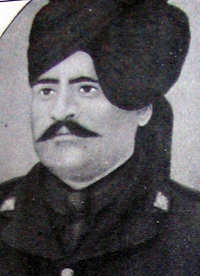
The rular areas of Marwar region are dominated by farming communities. The farmers of the Marwar region are considered to be the most simple in the state of Rajasthan. The most dominating farmer community in the rural areas of Marwar is Jat. The Jats are politically and economically very sound. The major land holdings in the present times are with Jats. Then comes the Rajput community who were the Jagirdars before independence. The Brahmins and Harijans also play important role in the area. The farmers of the region have done great struggle to come to the present status.
Though the position of Kisan (farmer) in what was Khalsa (under the direct control of the state) was better in comparison to a Kisan of the Jagir areas, he was only a little above a beast of burden. In Jagir areas of Marwar state before independence all cultivators were really landless. There was no tenancy Law and one could be thrown away from the land one cultivated at the pleasure of Jagirdar, his "malik". In most of the Jagirs a Jagirdar would in the first instance be taking fifty percent of the produce. This would be taken by actual division of the produce on the thrashing floor or by appraisal of the standing crop (kunta). The latter method proved at times more onerous as the appraisal depended on the whims of the Kamdar. Then over and above the share of the produce the farmer had to pay numerous "lags" or cesses. There were 64 kinds of begars (work without pay) prevalent in Marwar. Together with the share of the produce known as "Hasil" these cesses meant that the farmers had to part with more than eighty percent of their produce. The findings of the Sukhdeonarain Committee in the years 1940-42 bear this out. If a farmer had to marry his daughter he had to pay "Chavri Lag" if he held a dinner then a "Kansa Lag"; if members of the family separated then "Dhunwa Lag" and so on. If the Jagirdar had a guest then fodder for his mount had to be supplied. Then there was "begar" that is forced labour, for tilling the personal lands of the Jagirdar. The homestead in which the farmer lived in the Abadi had to be vacated in case he ceased cultivating the land. He could not alienate the plot to anyone. Then the bigger Jagirdars had judicial powers including magisterial powers. Further they had their own police force besides the revenue staff. This enabled them to keep their stronghold on the farmers. Over and above this policy of divide and rule was fully practiced. By offering the temptation of giving better land for cultivation one farmer would be set against another. There were no schools worth the name in rural areas and the masses were steeped in ignorance.
Jats in Marwar a formidable factor
The Jats in Bikaner, Jaipur and Jodhpur States were a formidable factor. The Jat community was the most numerous and largest single community in the Princely States of Bikaner, Jaipur and Jodhpur. The Maharajas, minor estates holders (feudatory) and their Kinsmen (the jagirdars) oppressed and suppressed the Jat Kisans in various manners forcing them to carry out agitations. Unfortunately the Imperial power (British) were always there to provide them much needed support. In the Shekhawati area of Sikar, Khetri, Nawalgarh, Dundlod, Bissau etc. the Jat Kisans carried out prolonged agitations against the feudal oppression form 1922 to 1930, 1930 to 1938 and from 1938 to 1947. The feudal lords grudgingly yielded and some concessions were wrested from them. The worst was exploitation in the name of “Begar” under which the Jat Kisan had to render free services by way of these feudal lords. They had to provide not only free labour but also their bullocks and carts too to their feudal lords. In Jodhpur State 84% of the kind was parceled out in Jagirs (feudal land lords) most of whom were Kinsmen of the Maharaja. Several of them held revenue and magisterial powers over their peasants against which there was no appeal. [12]
A glance at the Census Report of Marwar (Jodhpur State) for 1941 [13], would make one aware of the size of the Jat community in the State. The total population of the State was 25,55,904 out of which 3,54,342 or approximately 14% were Jats. In the Jat belt extending from Malani paragana (present Barmer District bordering Sindh province), Jodhpur paragana (Jodhpur district) Merta, Nagaur, Didwana and Parbatsar paraganas (present Nagaur district) the Jats formed nearly 30% of the total population, not an insignificant proportion by any standard. Their capacity to create trouble in the State can, therefore, be easily visualized. If the Jats of Punjab formed the crux of the Pakistan problem, the Jat community in Marwar (Jodhpur State) was no less the crux of problem in Marwar in the even the Maharaja acceded to Pakistan. As in Punjab in Marwar in the event of the Maharaja acceded to Pakistan. As in Punjab here also the question posed was, ‘Would this robust community meekly’ accept the accession of Jodhpur State to Pakistan? They would certainly resist it by force. This fact is also borne out by the advice rendered by Lord Mountbatten to the Maharaja that were he to do so serious communal trouble in the state would be the inevitable consequence. V.P. Menon has quoted in the his book “ the integration of Indian States" that The community which could create trouble was none other than the Jat community which would have resisted this decision by force. [14]
The Marwar Kisan Sabha was organised to ventilate grievances of the predominant Jat Kisans. The Marwar Kisan Sabha held its annual session in 1943 where Chowdhary Sir Chhotu Ram then Revenue Minister in Punjab, was invited as the Chief Guest. The Main Resolution among others that was settlement operations in the Jagir areas which was vehemently opposed by the leading Jagirdars. The on going Kisan agitation finally culminated in what is known as “Dabra Kand’ a veritable Jallianwalla Bagh. [15]
The Dabra Kand, a black deed and watershed
The peasant movement which was being orgainsed by the Marwar Kisan Sabha and the Marwar Lok Parishad jointly was a parallel movement to that of the national movement going on in British India whose aims were common i.e. to free the country form foreign rule. To mobilize the peasants, meetings under the joint auspices of Marwar Lok Parishad and Marwar Kisan Sabha were held at various place in the Jat belt and such meeting was fixed at village [Dabra]] in Nagaur district for 13th March 1947. The Jagirdars got together in a bid to crush the political awakening among the Kisan and the black deed at Dabra was planned. In this the Jagirdars had the blessings and active support of the Maharaja. The Kisan Sammelan was to have been addressed jointly by leaders of Marwar Lok Parishad and Kisan Sabha. The jagirdars had collected nearly a thousand Rajputs of the surrounding area and had begun massive preparations three day in advance of the Kisan gathering to teach a lasting and final lesson to the agitating peasantry and the Jats in particular. The Jat troops of Jodhpur Sardar infantry, who were on leave at that time having returned from Hongkong, participated in large number in this gathering. As soon as the peasants started congregating on the morning of 13th March, 1947 they were attacked by the Jagirdars and their henchmen wielding guns and swords. These armed ruffians started to terrorize the village, ransacking and putting fire to the thatched huts. In this premeditated and murderous attack five Kisans, four of them Jats were killed. Among the killed, three Jats were soldiers from Jodhpur Sardar infantry namely Rugha Ram, Ramu Ram and Panna Ram, Subedar Kisan Ram and Sepoy Bodu Ram both of Sardar infantry were among the grievously injured. Subedar Kishna Ram was blinded during this attack while protecting the defenseless villagers. Bodu Ram had both his arms broken. Sarvashri Mathurdas Mathur, Dwarkadas Purohit , Chhagan Raj Chopasniwala, Kishan Lal Shah of the Lok Parishad and Narsinh Kachhwaha of the Kisan Sabha received grave and serious injuries. They were dragged into the Jagirdar’s Kot (Fort) and were left there for dead. Even women were not spared and many of them received grievous injuries. Smt. Tulsi had her legs cut off by sword blows and Smt. Kesar also received grave injuries. The State civil and police authorities swung into action and registered cases of rioting, rebellious conduct and murderous assault against the unarmed and peaceful but gravely injured victims and prosecuted them. [16]
It was also commonly held that this black deed known as ‘ Dabra Kand’ had been carried out with the blessings of the Maharaja. This has been narrated poignantly by Shri Ram Kisen Kalla in his book “ Dabra Ki Kahani, Usi Ki Jabani’ (Hindi). A martyrs’ column has been erected in the village upon which names of those killed have been inscribed. Sobhag Mathur in his book “ Struggle for Responsible Government in Marwar” writes: “The Dabda Kand was one of the blackest deeds of Marwar feudalism”. This black deed had evoked widespread protest both in the press and in public. The weekly paper “Praja Sewak” of Jodhpur condemned it in unequivocal language. The Bombay weekly ‘vandematram’ while holding the Maharaja responsible for this tragedy declared, “it will shake the foundation of his throne.” ‘Janambhumi’ another Bombay weekly said, ‘The blood spilled in Dabra will grow into the plant of freedom in which the Rajas and Nawabs will have no place’. ‘the Lokvani’ of Jaipur described the tragedy at Dabra as “ Sensational and an armed attack on non violent persons as disgrace to mankind.” The Regional Committee of the All India States peoples Conference for Rajputana adopted a resolution against jagirdari repression, condemned the “Dabra Kand” and blamed the Maharaja and his Government”. The Dabra Kand was a veritable Jallanwalla Bagh and indeed proved to be a watershed in the peasant agitation in Jodhpur State. [17]
Abolition of Jagirs
The oppression of the public by traditional Samants (chiefs) and Jagirdars (feudatories) of Marwar state made their life difficult, which led to a class war. In urban areas, Jaynarayan Vyas started agitation against oppression, under the banner of "Marwar Lok Parishad" founded on 16th May 1938. This movement was supported by National Congress. The persons who played important role in "Marwar Lok Parishad" were: Shiv Dayal Dave and Jorawar Singh Oswal of Nagaur, Kishanlal Sahu, Manak Chand Konari and Sari Mal of Kuchaman, Tulsiram of Didwana, Srikishan Pandit of Kolia and Sukhdev Dipankar of Ladnu.
Rural masses of Marwar were united by Kisan Kesari-Baldev Ram Mirdha under the banner of "Marwar Kisan Sabha" founded in 1940. After the formation of Rajasthan, Baldev Ram Mirdha who had by then retired from Government service formed the "Rajathan Kisan Sabha" and unified the Kisans of Rajasthan under its banner. He was its first president. Since the broad objectives of the Kisan Sabha and the congress were identical the congress leaders approached Baldev Ram Mirdha to unite the Rajasthan Kisan Sabha with the Congress. Baldev Ram Mirdha was a visionary and he realized that the two could not and should not remain separate. Therefore, he just made one demand from the national leaders that the Jagirs be abolished forthwith in Rajasthan. This was agreed to by the Congress high command with the result that the Jagirs were soon abolished. A tenancy law was passed and the cultivating farmers were made the owners of the land.
Khejarli movement for saving trees
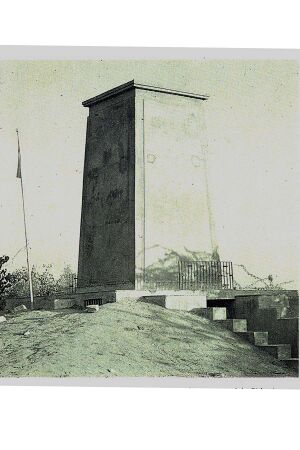
Khejarli or Khejadli is a village in Jodhpur district of Rajasthan, India. The name of the town is derived from Khejri (Prosopis cineraria) trees, which were in abundance in the village. In this village 363 Bishnois had to sacrifice their lives in 1730 AD for protecting green trees.
Origin of Chipko movement
It is the place where Chipko movement originated in India. It was a Tuesday, black Tuesday in Khejadli. 10th day of the bright fortnight of the month Bhadra (Indian lunar Calendar) in 1730 A.D. Amrita Devi a mother of three daughters viz. Asu, Ratni and Bhagu bai was at home with her daughters. Suddenly, she camae to know that many people had descended in their otherwise sleepy village. It was a party of Maharaja Abhay Singh, Ruler of Marwar (Jodhpur) state who wanted to fell green Khejri (Prosopis cineraria) trees to burn lime for the construction of his new palace. Since there was a lot of greenery in the Bishnoi villages even in the middle of Thar Desert, the king ordered his men to get the woods from Khejri trees.
Amrita Devi sacrificed for saving trees

Amrita Devi protested against King's men attempting to cut green trees as it was prohibited in Bishnoi religion. The malevolent feudal party told her that if she wanted the trees to be spared, she should give them money as bribe. She refused to acknowledge this demand and told them that she would consider it as an act of ignominy and insult to her religious faith. She said that she would rather give away her life to save the green trees. It is at that stage she spoke these words:
- "Sar sāntey rūkh rahe to bhī sasto jān"
- (If a tree is saved even at the cost of one's head, it's worth it)
Saying these words, she offered her head! The axes, which were brought to cut the trees, severed her head from her trunk. The three young girls Asu, Ratni and Bhagu were not daunted, and offered their heads too!!
Mass movement to protect trees
The news spread like wildfire. Bishnois gathered and sent summons to 83 Bishnoi villages to come and decide on the next course of action. Since the supreme sacrifice by those four had not satisfied the royal party, and the felling of green trees was continued, it was decided that for every green tree to be cut, one Bishnoi volunteer would sacrifice his/ her life. In the beginning, old people voluntarily started holding the trees to be cut in an embrace as in the Chipko movement of 20th Century in Uttar Pradesh (India).
363 Bishnois became martyrs
In this way many valiant old persons gave away their lives, but it failed to have the desired impact. Moreover, the Hakim (Royal party's leader) taunted the Bishnois that in this manner they were offering unwanted old persons. Soon, young men, women, including recently married ones and children were sacrificing themselves in a similar manner.
There was intense pandemonium. It completely shook the tree-felling party, headed by their leader Girdhar Das Bhandari (Hakim), they left for Jodhpur with their mission unfulfilled and told the Maharaja about what had happened. As soon as he learnt it, he ordered stoppage of the felling of trees.
By that time, Three Hundred and Sixty Three (363) Bishnois, young and old, men and women, married and unmarried, rich and poor had already become martyrs. Gotra wise number of these martyrs was as under: Achra (1), Badaderi (1), Badiyani (1), Chotiya (1), Degipal (1), Dudan (1), Geela (1), Goyal (1), Janwar (1), Jewlia (1), Jhuria (1), Kalirani (1), Khavi (1), Khichar (1), Kupasiya (1), Lamba (1), Maal (1), Ranwa (1), Sigar (1), Tandi (1), Vasu (1), Adina (2), Bhadiawas (2), Bola (2), Jhangu (2), Manju (2), Punia (2), Thalod (2), Bhanwala (3), Burdak (3), Chahar (3), Dhatarwal (3), Potalia (3), Rahad (3), Siyol (3), Bhadia (4), Dhayal (4), Isram (4), Karhwasra (4), Bhangarwas (5), Dukiya (5), Khava (6), Khileri (6), Lol (6), Nain (6), Sahu (6), Sinwar (6), Dhaka (8), Dara (9), Dudi (10), Kaswan (10), Khod (10), Khokhar (10), Panwar (10), Asiagh (13), Not clear (22), Jani (15), Saran (18), Babal (22), Beniwal (25), Bhadu (26), Godara (37)
List of Khejarli martyrs
The complete list of Khejarli martyrs can be seen here -
The tree felling banned
Honouring the courage of the Bishnoi community, the ruler of Jodhpur, Maharaja Abhay Singh, apologized for the mistake committed by his officials and issued a royal decree, engraved on a copper plate ordering the following:
- (A) All cutting of green trees and hunting of animals within the revenue boundaries of Bishnoi villages was strictly prohibited.
- (B) It was also ordered that if by mistake any individual violated this order, he would be prosecuted by state and a severe penalty imposed.
- (C) Even the members of ruling family did not shoot animals in or even near the Bishnoi's Village
Although, Bishnois paid a huge price for saving a few trees, this incident had inspired, and will continue to do so in future, many others to fight and protect trees and wild life.
Jat Gotras in Jodhpur district
Jodhpur is the center of Marwar region and is important Jat belt. We do not have any combined report which can give details about the distribution of Jat gotras in Marwar region. Jat Samaj Magazine, December 2006 issue gives membership list from All the states, the region of Marwar is also there. We find that maximum membership from any district in Rajasthan is from Jodhpur. There are large number of people who use Chaudhary, Jat or no surname. Out of these people with gotra as surnames were selected and tabulated. These are 236 people and 112 gotras. The figure after gotra is the count out of 236 from which we can roughly assess comparative population of that gotra. Here is the list:
Anwla 1, Atri 1, Ausu 1, Badeta 1, Badiyasar 1, Bambal 1, Banga 1, Banta 1, Barra 1, Beda 2, Behra 1, Benda 1, Beniwal 6, Bhadla 1, Bhadu 2, Bhakal 2, Bhakar 3, Bhambhu 3, Bhanun 1, Bhanwaria 1, Bhaskar 1, Bhinchar 1, Bhukar 1, Bijarnia 1, Chahar 1, Chhaba 1, Chhirang 2, Dara 1, Dater 1, Dawan 1, Delu 1, Dhaka 2, Dhatarwal 8, Dhauliya 1, Dhayal 1, Dhidariya 1, Dimaniya 1, Dogipal 1, Dorwal 1, Dudhwal 1, Dudi 10, Duktawa 3, Fadak 1, Fadauda 1, Garu 1, Gawaria 1, Ghat 1, Godara 11, Gurjar 2, Gwala 1, Hardu 1, Hooda 10, Jakhar 14, Jaliyawda 2, Jalwania 1, Jandu 2, Jhajharia 1, Jyani 4, Kachchhawa1, Kajla 1, Kakrawa 1, Kala 1, Kalirana 1, Kamediya 3, Kapdia 1, Karwasra 1, Kaswan 4, Kataniya 1, Khod 1, Khoja 8, Khot 2, Kot 1, Lamrod 1, Latiyal 1, Lol 2, Machra 3, Maderna 3, Makar 2, Malhan 1, Mayla 2, Mehria 1, Mirdha 3, Mothra 2, Mundan 2, Mundel 3, Mundiyara 1, Nahar 1, Nardhaniya1, Pachar 1, Padoda 1, Pawar 1, Pichkya 1, Pilania 1, Punia 7, Ralia 1, Rayal 1, Rewad 1, Sabarwal 1, Sail 2, Sangwa 2, Sani 1, Saran 16, Senwar 2, Shail 1, Sheoran 1, Shihag 1, Sinwar 1 Sirohi 1, Siyol 3, Sou 1, Tada 1, Tandi 3, Thori 1,
We find from above list that Saran (16) is the biggest gotra in Jodhpur district followed by Jakhar (14), Godara (11), Hooda (10), Dudi (10), Khoja (8), Dhatarwal (8), Punia (7), Beniwal (6), Kaswan (4), Jyani (4) etc in decreasing order.
Jat gotras in Nagaur district
As per the member list of Jat Samaj Agra, December 2006, the Jat gotras in Nagaur district are:
Bajya, Balhara, Bapedia, Batesar, Beda, Beerda, Bhakal, Bhakal, Bhambhu, Bhinchar, Bisu, Bugalia, Chandelia, Dabola, Danga, Dantusliya, Dhaka, Dhauliya, Dhayal, Didel, Dookya, Dugastawa, Farauda, Galwa, Garhwal, Garu, Gatiyal, Godara, Golia, Inania, Jajra, Jakhar, Janjhaliya, Kalwania, Kanwalada, Karwasra, Kaswan, Khadaw, Kharra, Khudkhudia, Kukana, Lamrod, Loyal, Manda, Matwa, Mawlia, Meel, Mehria, Mundaliya, Mundel, Murawatia, Muwal, Netad, Netra, Nimbad, Pichkiya, Punia, Ranwa, Sangwa, Saran, Senwar, Shahu, Sirohi, Sou, Tada, Thalod, Tholia,
Jat Gotras in Barmer district
Barmer is the western part of Marwar region and is important Jat belt. We do not have any combined report which can give details about the distribution of Jat gotras in Marwar region. Jat Samaj Magazine, December 2006 issue, which gives membership list. I find that maximum membership from any district in Rajasthan is from Jodhpur followed by Barmer. There are large number of people who use Chaudhary or no surname. Out of these people who put gotra as surnames were selected and tabulated. These are 201 people and 57 gotras in Barmer district. The figure after gotra is the count out of 201 from which we can roughly assess comparative population of that gotra.
Bairad 5, Balhara 1, Bana 1, Beniwal 23, Bhadu 3, Bhagaur 1, Bhakar 1, Bhambhu 4, Bhanwaria 1, Bhaumu 1, Bhukar 2, Bidiyasar 1, Deswal 1, Dhaka 1, Dhatarwal 5, Dhedu 1, Dookya 8, Dudi 2, Duger 1, Ghat 1, Godara 19, Gorasia 1, Gujar 1, Hooda 2, Isram 2, Jajra 1, Jakhar 10, Jandu 1, Jyani 3, Kakad 1, Karwasra 7, Khot 1, Kukana 1, Langoria 1, Legha 3, Lol 1, Lukha 2, Machra 2, Manwal 1, Moond 1, Moonth 1, Muralia 1, Nain 2, Nehra 1, Pawda 2, Potalia 1, Punia 6, Sahu 2, Sani 1, Saran 24, Sau 12, Senwar 1, Sihag 13, Siyol 1, Tandi 1, Tetarwal 1, Thori 6,
The biggest gotra in Barmer district from above analysis is Saran (24) and Beniwal (23), followed by Godara (19), Sihag (13), Sau (12), Jakhar (10), Dookya (8), Karwasra (7), Thori (6), Punia (6), Dhatarwal (5), Bairad (5), Bhambhu (4) etc in decreasing order.
External links
Foot notes
- ↑ Imperial Gazetteer of India, v. 17, p. 213.
- ↑ ततश च यात्वा मरुधन्व पार्श्वं; सथा धनुर्वेथ रतिप्रधानाः, सरस्वतीम एत्य निवासकामाः; सरस ततॊ दवैतवनं परतीयुः (III.174.21)
- ↑ तत्र युद्धं महद वृत्तं शूरैर मत्तमयूरकैः, मरु भूमिं च कार्त्स्न्येन तदैव बहु धान्यकम (II.29.5)
- ↑ ततः पञ्चनथं चैव कृत्स्नं च कुरुजाङ्गलम, तदा रॊहित कारण्यं मरु भूमिश च केवला (V.19.29)
- ↑ अपरन्ध्राश च शूद्राश च पह्लवाश चर्म खण्डिकाः, अटवी शबराश चैव मरु भौमाश च मारिष Mahabharata (VI.10.46)
- ↑ Aitihasik Sthanavali by Vijayendra Kumar Mathur, p.737
- ↑ Aitihasik Sthanavali by Vijayendra Kumar Mathur, p.712
- ↑ Aitihasik Sthanavali by Vijayendra Kumar Mathur, p.713
- ↑ Thakur Deshraj:Jat Jan Sewak, 1949, p.167-170
- ↑ राजस्थान के जाटों का इतिहास,2010, पृ.14
- ↑ राजस्थान के जाटों का इतिहास, 2010, पृ.19
- ↑ D.R. Chaudhary: “The Role of Jats and their contribution to the Polity of North-West India”, The Jats, Vol. II, Ed Dr Vir Singh, Delhi, 2006, p. 294
- ↑ The Census Report of Marwar (Jodhpur State) – 1941, published by Government of Jodhpur
- ↑ D.R. Chaudhary: “The Role of Jats and their contribution to the Polity of North-West India”, The Jats, Vol. II, Ed Dr Vir Singh, Delhi, 2006, p. 295
- ↑ D.R. Chaudhary: “The Role of Jats and their contribution to the Polity of North-West India”, The Jats, Vol. II, Ed Dr Vir Singh, Delhi, 2006, p. 295
- ↑ D.R. Chaudhary: “The Role of Jats and their contribution to the Polity of North-West India”, The Jats, Vol. II, Ed Dr Vir Singh, Delhi, 2006, p. 296
- ↑ D.R. Chaudhary: “The Role of Jats and their contribution to the Polity of North-West India”, The Jats, Vol. II, Ed Dr Vir Singh, Delhi, 2006, p. 296
References
- Rosemary Crill Marwar Paintings: A History of the Jodhpur Style, India Book House, Mumbai, 1999 ISBN: 8175081392
- Bakshi, S.R. & et. al. (Eds.) Marwar and its Political Administration; Delhi, 2000 ISBN: 81-7629-224-9
- Tod, Payne, C.H. Annals of Rajasthan Annals of Marwar HC., 1994, ISBN 8120603508
- Colonel James Tod: Annals and Antiquities of Rajasthan, Oriental Books, New Delhi, 1994
- D.K.Taknet: “Heroes of a Desert Land” in B.M.Birla: A great visionary, Indus, New Delhi, 1996
- Mohanram Maruka: “Marwar ka Itihas” in Jat Samaj (January-February, 1998), Agra
- Illan Cooper: “What is in a name”, Marwar: A chronical of Marwari History and Achievement, Arpan Publications, Mumbai, 1996
- Illan Cooper: “A painted History”, Marwar: A chronical of Marwari History and Achievement, Arpan Publications, Mumbai, 1996
- D.K.Taknet: Marwari Samaj Aur Brijmohan Birla, Indian Institute of Marwari Entrepreneurship, Jaipur, 1993ISBN 81-85878-00-5
- Dr Natthan Singh: Jat-Itihas, Jat-Samaj Kalyan-Parishad, Gwalior, 2004
- Jat Samaj, Agra, December 2006
Back to Places
Back to Jat Kingdoms in Ancient India



